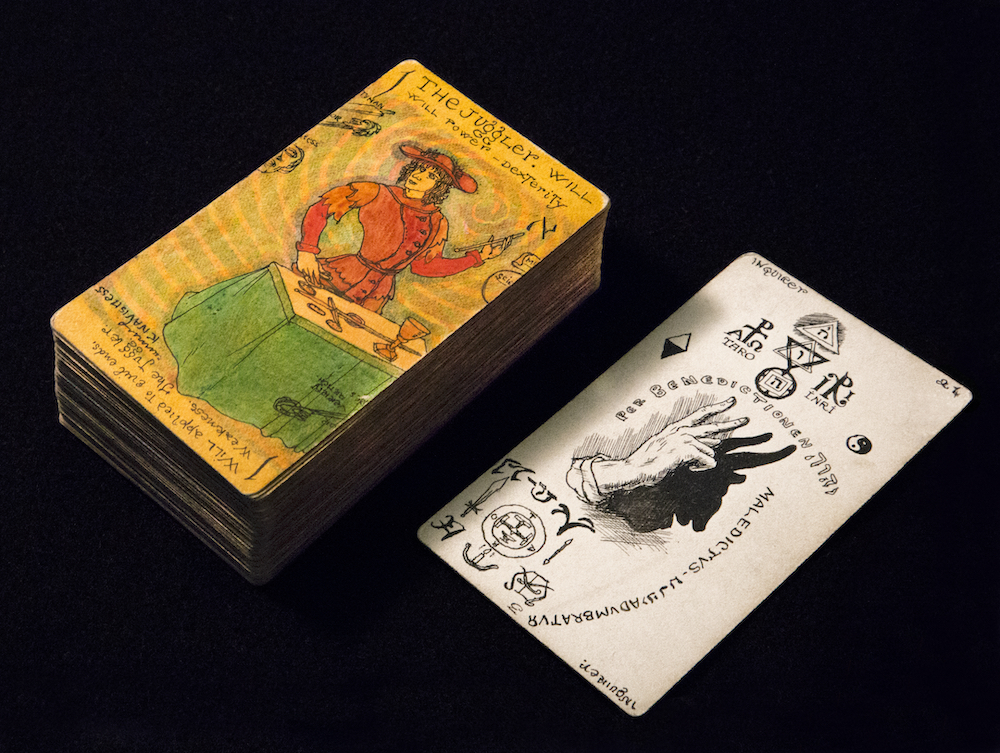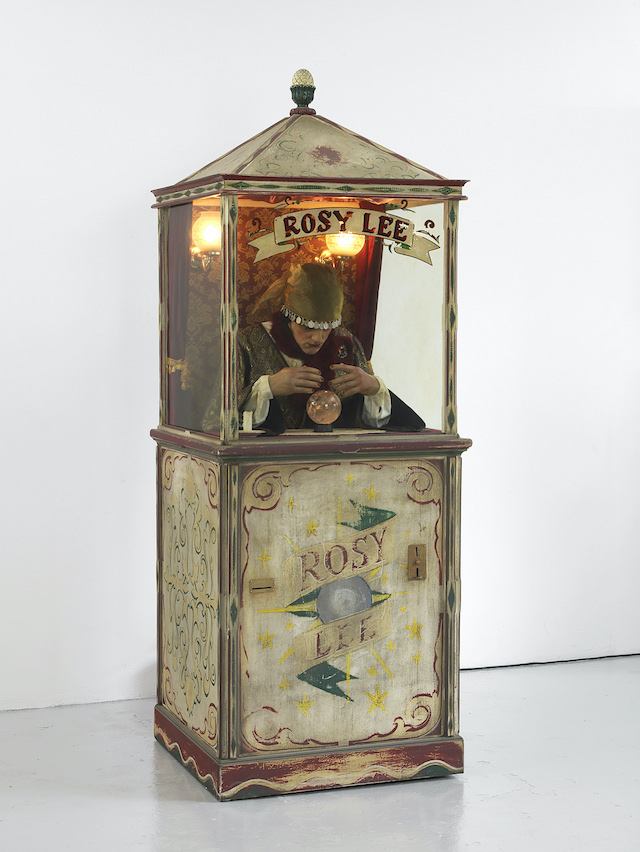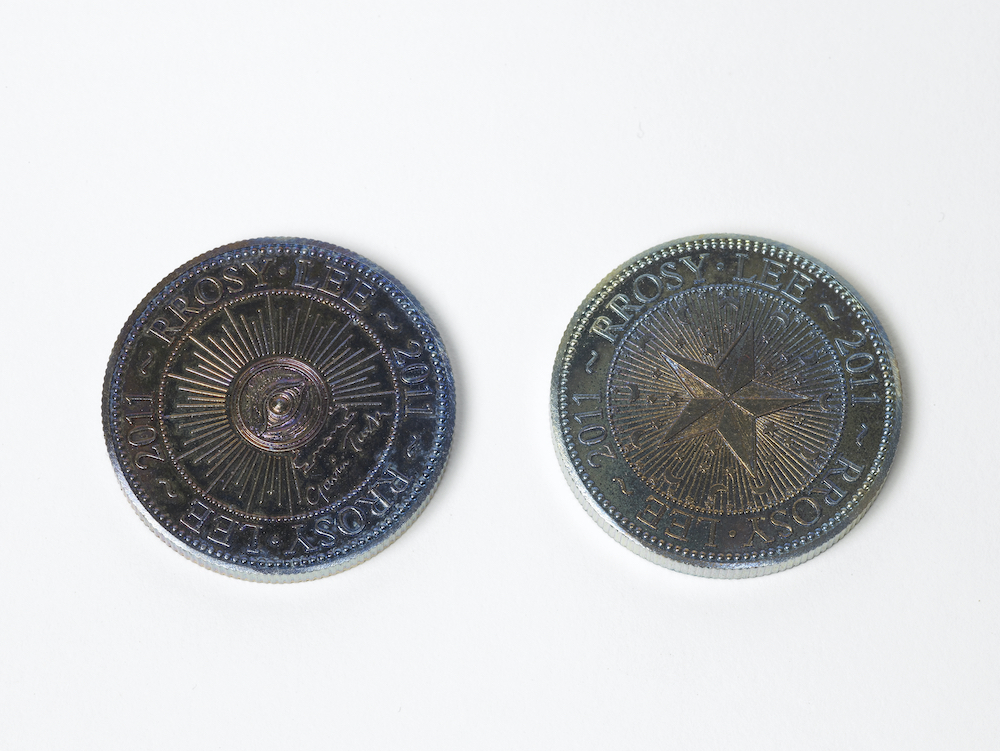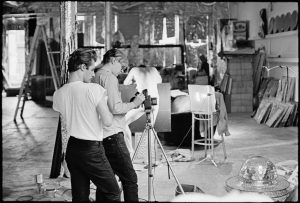What alternate worlds may be summoned from card reading? Gavin Turk invites artist and writer Jonathan Allen – who rediscovered mystic and artist Austin Osman Spare’s lost tarot deck – to discuss the history of cartomancy and how it might imaginatively model possible futures

Gavin Turk: Looking into the future and thinking about the role of artists, there’s a wonderful line from the British artist and mystic, Austin Osman Spare. He wrote that “Scientists will never solve or prove anything relating to foretelling the future; it is a work for ‘artists’. Science may subsequently prove more fully what the artists have already discovered.” In terms of “foretelling the future”, I wanted to ask you about a project that you’ve been involved with recently that was based around your discovery of a lost tarot deck made by Austin Spare, one that got you thinking about cartomancy as a tool for reimagining the future. I wonder if you could tell me how you found this amazing artefact.
Jonathan Allen: From time to time, I work as an associate curator at London’s Magic Circle Museum, which is connected to the well-known international organisation for theatrical conjurors and illusionists. The Magic Circle’s remit is to promote the conjuring arts but importantly that also includes exploring magic’s cultural history. As with all museums, the collection contains items that don’t strictly ‘belong’ to the official story of that institution, and at the Magic Circle that includes Austin Spare’s forgotten tarot deck. I stumbled across the cards one quiet April evening in 2013 as I was preparing material for a lecture. The cards were packed away in a cupboard surrounded on all sides by vitrines filled with magic props, and when I realised what I had in my hands, I couldn’t quite believe it. Over the next few years, I put together the book Lost Envoy, in which the cards were reproduced for the first time, and where lots of great people discuss the deck. Reactivating the cards was also very interesting for me as an artist, and resulted in several exhibitions and a short film called ‘Le Carte Parlanti’ (2017).
In the first ‘phase’ of tarot history, tarot cards do seem to relate to the kind of magic that ends in a ‘c’ as opposed to a ‘k’.
If by that you mean that tarot cards developed in a secular context, then yes. Although some people still think of tarot as coming from a long-lost mystical tradition, most of its iconography actually has its origins in the decadent Court of Milan in northern Italy sometime around the beginning of the 15th century. During that period, the cards were part of a skill-and-chance-based game that also functioned as an allegory for life. The well-known ‘Visconti’ decks contain narrative elements that are connected directly to the Visconti family, and so you can probably assume that as they played what was basically a recreational trick-taking card game, they were also thinking about their family’s legacy. It was only later, in the second half of the 18th century in France, and then again in the late-19th and early-20th centuries in Britain, that tarot cards really developed as a divinatory tool. Since theatrical magicians have conventionally been sceptical of many esoteric magical practices, it’s pretty remarkable that Spare’s deck – which is essentially a relic of the British occult revival – ended up in the collections of the Magic Circle. We think that Spare hand painted the cards around 1906; they were then donated to the collection in the mid-1940s, but because of the Magic Circle’s strict code of secrecy, the cards went underground. I always think that the deck therefore effectively ‘missed’ the 20th century, and its influence is only now starting to be felt, at a time when there’s a lot of speculation, and anxiety, about the future.

So an artefact that’s been dormant for over a hundred years, made by an outsider artist who very few people have really taken an interest in, begins to affect historical timelines and starts to reshape things. Histories aren’t fixed, as we know from the situation with other more public-facing artefacts like, say, the stolen Benin Bronzes, which are now gradually being returned, and as a result history is getting a rewrite. It also seems important to move forward together into the future, in ways that embody how we’d like it to be – for instance, articulated by more female voices, and recognising and learning from indigenous knowledge. The flexibility of history and the possibility of different futures is something that we seem to come back to with the idea of the tarot. Card reading is an interesting speculative process: You select a set of random cards in a non-conscious way, whereupon a series of images are laid out as a structurally significant spread; this then starts to guide a conversation, perhaps even a narrative. That narrative exists only because of the order in which the cards have fallen and their position in relation to one another. Accidental themes are captured, instilled, stopped, and given meaning.
I should say that Spare wasn’t really an “outsider” artist. He actually trained at the Royal College of Art, in London, where he was a close friend of the artist and suffragette Sylvia Pankhurst. In Lost Envoy, Sally O’Reilly imagines a conversation between the two of them in which Spare’s deck appears. But yes, in more general terms, tarot card reading is a very flexible and open way of structuring a conversation. I don’t really think of card reading as being about ‘predicting’ or ‘foretelling the future’, but more as a way of anchoring communication in the present and then exploring that moment’s various contingencies. A card reading invites its participants into a shared imaginative space where intermediary objects summon temporary alternate worlds. In the case of tarot cards, those worlds draw on an art-historically complex iconography, but Spare openly encouraged people to create their own imagery – hence it being “a work for artists” in the broadest sense.

Tarot readers sometimes get a bad rap for manipulating vulnerable people who pay them to read their cards. Our world feels pretty vulnerable at the moment, and there are certainly plenty of dodgy characters out there ready to tell us their warped stories about the future.
It’s fairly easy to dismiss the whole area of cartomancy on the basis that people only hear what they want to hear, and that tarot readers play into our confirmation biases and rely on responses that are so open-ended that they’re basically meaningless… the so-called ‘Barnum statements’. Bad-faith actors are certainly out there. But I think there’s a more generous and actually more challenging way to approach all of this. Emily E Auger has described tarot cards as “heterotopian”, that is they mark out a space that’s outside of all other spaces, where judgment is temporarily suspended and possibility can abound. In that way, card reading can certainly become a space for imaginatively and collectively modelling different possible futures, as contemporary decks like Suzanne Treister’s Hexen 2.0 Tarot, the Plastique Fantastique Tarot, Sophy Hollington and David Keenan’s Autonomic Tarot, and Katie Anderson’s Barrow Tarot all demonstrate. But to actually build a future, you have to engage the real world in very practical and unavoidably political ways. This comes up in O’Reilly’s imagined conversation between Spare and Pankhurst, where Pankhurst dresses Spare down for spending so much time mapping his inner world, while the suffragettes were being imprisoned for trying to reconstruct the social conditions around them.

Another way of looking at Spare’s deck is as a resonator that uses a given system and creates new stories and possibilities every time you look at it.
I like the idea of the deck being a kind of disruptive resonator. One of the most interesting and unprecedented things about Spare’s deck is that he drew and wrote across the vertical edges of the cards, so there’s information half on one card and half on another. When you put various cards together, they form visual links at their margins. But that doesn’t mean that they all fit together harmoniously like a jigsaw puzzle. Instead, when one of the visual devices links up, it means that other ones clash, and vice versa. The resulting array of connections and misconnections feels very contemporary to me, where some paths we take enable us to get to somewhere pretty easily, while at the same time other paths are blocked to us.
And when the deck got hidden, an experimental feature like that didn’t become mainstream within card reading circles. I really like the built-in chaos of that system: There are occasional wormholes, but if you go back and retrace your steps, you suddenly find the hole is taking you somewhere else. I think where we are at the moment can feel incredibly polarised; we’re often glued to our screens, our little wormholes. As the internet learns our online consumption habits and starts to limit our experiences, it’s a relief to see the systemic unpredictability of this artwork.
Yes, I agree. I reckon that Italo Calvino might have been interested in the deck if he’d seen it, given his love of tarot’s combinatory system and its potential for open story telling. I think that the deck is, as much as anything else, an early example of a combinatoric artwork. And although the deck’s disappearance meant that it didn’t have a historical influence at the time, the spirit of what Spare was doing manifested in other ways. The deck’s connecting devices have the feel of a surrealist game, like an infinite version of the exquisite cadaver, or something along those lines. A very memorable headline appeared in a London newspaper in 1938, which referred to Spare as “The Father of Surrealism – He’s a Cockney”.
(*laughs) Well, would you Adam and Eve it!
Lost Envoy: The Tarot Deck of Austin Osman Spare (2016), edited by Jonathan Allen, was published by Strange Attractor Press and distributed by MIT Press

This article is taken from Port issue 29. To continue reading, buy the issue or subscribe here




